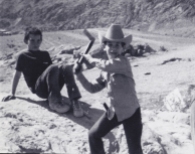My interest in photography came from watching my mother take photos. She had an old Rolleiflex that only she understood. It was square and boxy with two lenses on the front and some knobs on the sides. The magical thing about this camera is that you had to look down into a prism to take the photo – before an LCD screen even existed, many photographers had grown to love the experience of framing their shots in that lovely square box – it was like watching a TV screen.
Mom’s camera was just a bit newer than this one – it was probably from the 1950s. One day in my early teens we were on a trip with some other girls and their moms when she decided to show me how it worked. It wasn’t something she trusted me to take off with it, but that day I saw photography differently – somehow in my mind it shifted from capturing snapshots to making something look great on that screen. With the Rollei you had to move – there was no zoom or macro settings – you moved until the object you wanted to highlight was in focus. I think that early experience is why I love to shoot primes today. When I studied photography in college, mom entrusted me with not only her Rollei, but her new Pentax to use in my classes. I think it was at this time that I really understood photography as art – not just in the shooting of images, but in the processing and developing of film – the making of images.
Now my mom was a super-talented woman who never saw herself as an exceptional. She was a master pattern cutter, seamstress, and tailor. I would show her two dresses I liked – I would like the bodice on one and the skirt on the other – we would go home and she would make me a dress that was the perfect combination of the two. Her doodles on the phone book looked like the sketches you see designers make when developing fashion concepts. She was an amazing cook. She would try something new and then go home and figure out how to make it. She was exceptional in so many creative ways. If I were to call her a photographer she would probably cringe – but I look at her shots and I know that she had some skills. These aren’t etherial landscapes or anything like that – just shots of family and friends.
This Mother’s Day, like all days I miss her. She left us far too soon, but her mark on our lives was indelible.
She’s always with you. She’s the sound of bacon crackling in a skillet on Saturday morning. She’s the aroma of the lilacs and magnolias in the spring. She’s your breath in the air on a cold winter’s day. She’s the sound of the rain on the roof that lulls you to sleep, the colors of the rainbow; she is Christmas morning. She is the place where you came from, your first home, and she’s the map you follow with every step you take. She’s your first love, your first friend, even your first enemy, but nothing on earth can separate you – not time, not space, not even death.
Shutterbug Notes:
You can learn a lot from looking at old photos. As your skill grows you can appreciate the skill it took to make them work. You can also learn a lot about shooting from the heart – to not so much try to capture what something looks like, but what it feels like. It’s more that skill that makes a great image – it needs heart.



















